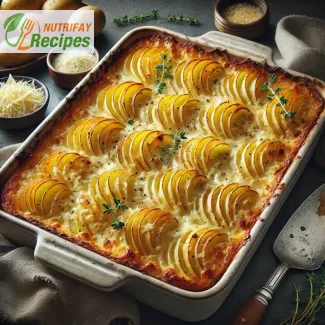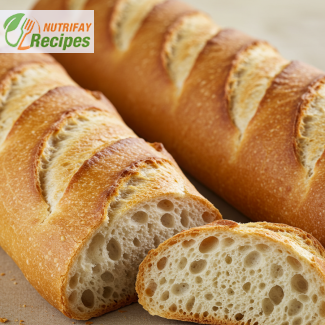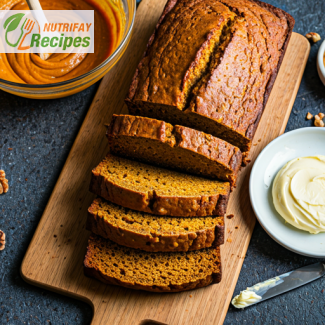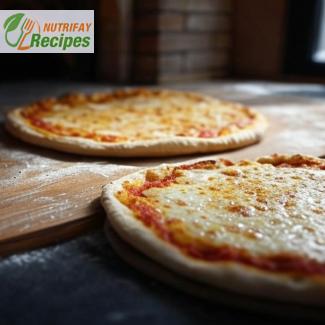Few dishes capture the essence of comfort food like a well-prepared potato gratin. This classic recipe combines thinly sliced potatoes, a rich and creamy sauce, and the irresistible allure of melted cheese. Perfect for family dinners, festive gatherings, or as a standout side dish, potato gratin transcends seasons and occasions. Its simplicity is matched only by its ability to deliver bold, hearty flavors that warm both the heart and soul.
A Timeless Culinary Tradition
The origins of potato gratin trace back to French cuisine, where its name, "gratin," refers to a dish baked with a golden crust. Traditionally, this crust comes from a combination of bubbling cheese and breadcrumbs, though modern variations focus on the natural creaminess of the potatoes and cheese. This recipe celebrates that heritage while offering a few modern touches to make preparation simple yet impressive.
Why Potato Gratin Stands Out
The appeal of potato gratin lies in its perfect balance of texture and flavor:
- Creamy layers of potatoes infused with a savory, velvety sauce.
- A golden, slightly crisp topping of melted cheese that adds a delightful contrast to the soft potatoes beneath.
- A subtle blend of garlic, thyme, and a hint of nutmeg, bringing depth without overpowering the main ingredients.
Whether served alongside a roast, paired with grilled vegetables, or enjoyed on its own, this dish adapts seamlessly to various menus. It’s equally suitable for casual meals and elegant dinners, making it a must-have recipe in any chef’s repertoire.
The Perfect Pairing of Ingredients
Each ingredient in this recipe plays a pivotal role in delivering its signature flavor:
- Potatoes: Choose a starchy variety like Russet or Yukon Gold for a soft, creamy texture.
- Cheese: Gruyère or Parmesan enhances the dish’s richness with their nutty, tangy profiles.
- Cream and Milk: Combine for the ultimate luscious base that envelops the potatoes in silkiness.
- Seasonings: A pinch of salt, a dash of pepper, and fragrant herbs elevate the dish while keeping it approachable.
A Simple Yet Impressive Presentation
While the ingredients are humble, the presentation of potato gratin is anything but. Its neatly layered slices create a beautiful visual pattern, while the golden crust adds a rustic charm. Served in a ceramic baking dish or plated in individual portions, it’s a feast for both the eyes and the palate.
Nutrition Meets Indulgence
Potato gratin offers more than indulgent flavor. Potatoes are an excellent source of vitamin C, potassium, and fiber, while the cheese contributes a healthy dose of calcium and protein. Although rich, this dish can be part of a balanced diet when enjoyed in moderation.
Versatility for Every Occasion
Potato gratin’s versatility makes it a star at any table. Pair it with:
- A roast chicken or beef tenderloin for a hearty, traditional dinner.
- Grilled vegetables for a lighter, vegetarian meal.
- A crisp side salad to balance its richness with freshness.
With its timeless charm, creamy layers, and irresistible crust, potato gratin is more than a side dish—it’s a statement of culinary excellence. Whether you’re crafting a comforting family meal or impressing guests at your next dinner party, this recipe delivers every time. Dive into the satisfying world of potato gratin and discover why this dish has been cherished for generations.
Step 1: Prepare the Potatoes
- Preheat your oven to 180°C (350°F).
- Peel the potatoes and slice them thinly (about 3 mm or 0.1 inch thick) using a mandoline or sharp knife.
Step 2: Prepare the Cream Mixture
- In a saucepan, combine heavy cream, milk, minced garlic, salt, pepper, and nutmeg. Heat gently until warm but not boiling.
Step 3: Assemble the Dish
- Grease a baking dish with butter. Layer the potato slices evenly, slightly overlapping.
- Pour a portion of the cream mixture over the potatoes and sprinkle with Gruyère cheese. Repeat the process to create layers, finishing with the cream and Gruyère cheese on top.
Step 4: Add Parmesan and Bake
- Sprinkle the top with Parmesan cheese. Cover the dish with aluminum foil.
- Bake for 40 minutes, then remove the foil and bake for an additional 20 minutes, or until the top is golden brown and the potatoes are tender when pierced with a knife.
Step 5: Serve
- Let the gratin cool for 5 minutes before serving. Garnish with fresh thyme if desired.
Enhancing the Classic Potato Gratin Recipe
Potato gratin is a dish that celebrates simplicity and indulgence, yet it offers ample room for customization. By tweaking the ingredients or techniques, you can create unique variations of this classic recipe to suit your taste, dietary needs, or the occasion. Below are professional insights and tips to elevate your potato gratin to the next level.
Choosing the Right Potatoes
Starchy vs. Waxy Potatoes
- Starchy potatoes such as Russet or Yukon Gold are ideal for a creamy and tender gratin. Their high starch content allows the layers to bind well and achieve a melt-in-your-mouth texture.
- For a firmer texture, opt for waxy potatoes like Red Bliss or Charlotte. These hold their shape better but may result in a less cohesive dish.
Impact on Flavor and Texture
The choice of potato can significantly influence the creaminess of the gratin. Starchier varieties create a richer, more indulgent dish, while waxier potatoes provide a slight bite and subtle earthiness.
Adjusting the Cheese
Gruyère Alternatives
- Replace Gruyère with Cheddar for a sharper, tangier flavor.
- Use Fontina or Mozzarella for a milder, creamier result.
- Swap Parmesan with Pecorino Romano for a saltier and more robust topping.
Impact on Flavor
Changing the cheese allows you to tailor the gratin to complement the main course. For instance:
- Gruyère adds nuttiness, ideal for pairing with roast meats.
- Cheddar introduces boldness, perfect for barbecue or casual meals.
Exploring Alternative Cream Bases
Dairy-Free Options
- Substitute heavy cream with coconut cream or cashew cream. These provide richness without compromising the dish's luscious texture.
- Use almond milk or oat milk for a lighter version, but consider adding a thickener like cornstarch to maintain creaminess.
Health-Conscious Choices
- Replace part of the cream with Greek yogurt for a tangy flavor and added protein.
- Opt for low-fat milk or cream to reduce calories while maintaining the velvety consistency.
Experimenting with Herbs and Spices
Flavor Enhancements
- Incorporate fresh thyme, rosemary, or sage for a fragrant, earthy note.
- Add a pinch of paprika or smoked paprika to the cream mixture for a subtle smoky undertone.
Customization Ideas
Experimenting with herbs can transform the dish’s character:
- Italian herbs like oregano and basil create a Mediterranean twist.
- Middle Eastern spices such as cumin and turmeric add warmth and complexity.
Alternative Layering Options
Adding Vegetables
- Layer thinly sliced onions, zucchini, or eggplant between the potatoes for added depth and nutrition.
- Use spinach or kale for a boost of color and fiber.
Impact on Flavor and Appearance
Vegetable additions can add sweetness, earthiness, or a slight bitterness, depending on the choice. They also enhance the dish’s visual appeal with vibrant hues.
Tips for Texture Perfection
Achieving a Golden Crust
- Combine breadcrumbs with cheese for an extra crispy topping.
- Drizzle a small amount of melted butter over the top layer before baking to ensure even browning.
Avoiding Sogginess
- Dry the potato slices thoroughly after washing to prevent excess moisture.
- Ensure even layering and avoid over-packing the dish, which can lead to uneven cooking.
Scaling the Recipe
Smaller Portions
For individual servings, prepare the gratin in ramekins or small ovenproof dishes. This not only shortens the cooking time but also adds a touch of elegance to the presentation.
Larger Portions
When preparing for a crowd, use a deeper baking dish and increase the quantities proportionally. Cover the dish with foil for the first half of the baking time to ensure the potatoes cook evenly without over-browning the top.
Substitutions for Dietary Needs
Gluten-Free Modifications
This recipe is naturally gluten-free when all ingredients are certified gluten-free. To add a crispy topping without breadcrumbs, use crushed nuts or gluten-free panko.
Vegan Adaptations
- Replace the cream and cheese with plant-based alternatives. Nutritional yeast can add a cheesy flavor to the vegan version.
- Consider adding roasted garlic or caramelized onions for a richer depth of flavor.
Understanding the Impact of Changes
Flavor Profiles
- Substituting herbs, spices, or cheeses can shift the dish from classic French to Mediterranean, smoky American, or even exotic Middle Eastern.
- Adding vegetables introduces new dimensions, while varying the cream base can adjust the dish’s richness and sweetness.
Visual Appeal
- Fresh herbs or paprika dusting can brighten the presentation.
- Alternative layering with colorful vegetables enhances the gratin’s visual impact.
By experimenting with these tips and substitutions, you can make your potato gratin uniquely yours, whether you’re aiming for a lighter option, catering to dietary restrictions, or simply exploring new flavor combinations. This versatile dish offers endless opportunities for creativity while maintaining its comforting essence.
- Contains dairy (cream, milk, cheese).
- Gluten-free: Ensure all ingredients are certified gluten-free if necessary.
Substitution Tips:
- For a lactose-free version, use plant-based cream and cheese alternatives.
- Replace cheese with nutritional yeast for a dairy-free option.
- Vitamin C: 20 mg (22% DV) – supports the immune system.
- Potassium: 700 mg (20% DV) – essential for heart and muscle function.
- Calcium: 300 mg (30% DV) – strengthens bones and teeth.
- Iron: 1.2 mg (15% DV) – supports oxygen transport in the blood.
- Beta-carotene: Trace amounts – supports eye health.
- Vitamin E: 1 mg (7% DV) – protects cells from oxidative stress.
Potato gratin is a satisfying dish packed with essential nutrients and flavors, making it a versatile choice for any occasion.







